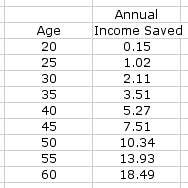If you haven’t learned by now, I am a spreadsheet tinkerer by nature. One thing I’ve been thinking about lately is the retirement savings one should have at different ages. A spreadsheet I’d written some time back came in handy to revisit this idea.
This snippet shows hows many year’s annual income one would have saved for retirement if they save a total 15% of their income each year and get an 8% annual return. In the spreadsheet, I make the assumption that 10% is their deposit and 5% is a company 401(k) match, but either way, it’s 15% of their gross income saved. Of course, one doesn’t save so linearly, it’s tough to get a twenty year old thinking about saving for a retirement that’s decades away. Nor will the investment return be so steady. My post titled A Change of Plans offers a somber warning about what can happen when you just continue to project ‘more of the same.’
Let’s look at these numbers for a moment. Two things that I’d call to your attention; First, there are no dollars shown. While that might seem a bit counter intuitive, it makes perfect sense. When people discuss retirement needs, the conversation often boils down to a replacement ratio, how much of your pretax income do you need to continue in your current lifestyle? The number is up for discussion, but 80% is the common answer. With a 4% withdrawal rate at retirement a savings equal to twenty times your final year’s earnings is about what you’d need to accomplish this. The second thing to note here is that the saving numbers are not linear, but exponential. At 8% return, your money will double every 9 years. So you need about half your retirement goal saved not halfway through your working career, but by about 10 years before you retire. Note also that the numbers I show take into account a rising income, for example, at 35, I show that one would have saved 3.5 of their current income. This process builds in the inflation adjustment by assuming your income will rise over time. You can see from these numbers that any rule suggesting that you have say 1/10 your age times your annual salary saved can’t possibly be accurate, and will only be valid at one particular pint in time, here at age 35. At 20, it would be impossible for a new worker to have 2 years salary saved up, yet for a 60 year old, 6 years salary won’t be enough to survive, not without relying on other sources of income.
Just something to think about, replacement rates will make a good topic for a future post.
Joe


Joe,
“When people discuss retirement needs, the conversation often boils down to a replacement ratio, how much of your pretax income do you need to continue in your current lifestyle? The number is up for discussion, but 80% is the common answer.”
I never understood this. If you are spending $100K, $200K or $300K/yr at age 64, why when you turn 65 does your need suddenly drop? Maybe it has to do with the mortgage being paid off, but maybe they are spending that amount with a paid off mortgage?
Thoughts?
Wouldn’t the pertinent number be “Annual Expenses Saved”?
I can answer how the 80% may be intuitive. Up to an income of $106,800 (in 2009) there’s payroll withholding (social security) of 7.65%, add another 12% or so for retirement savings and you’re right at that 80% number. Of course, I don’t fully buy into this number, it’s not a bad rule of thumb, but that’s all it is, a starting point. I once observed that 20% of our income went to savings, 20% to the mortgage, 10% to pay for childcare, 10% to save for college. That meant that for us, the magic number might only be 40%.
Another topic worth revisiting here is that the lower your income, the higher the replacement rate provided by social security. The $80K earner does not get twice the benefit of the $40K earner.
Thank you for your comment.
Absolutely. The step from income to expenses is required for my approach anyway, so by tracking expenses, and replacing that number 100%, you’re where you need to be (adjusting for post-retirement changes, of course.)
I think we are all agreeing – the real number that should be looked at is – expenses, right?
Absolutely. Whatever number you come up for expenses (in present dollars), just divide by present income. That’s the ratio I’d use. Multiply by 25 (or divide by .04) and that’s the target “years income” to track.
Is it possible to save TOO MUCH into 401K, or IRA, where the money is not accessible. Should a 40 year old, still single save as much as you indicated in your chart?
The question is not just ‘how much to save’ but also how? Should all retirement savings go into retirement accounts?
I recommend that one have enough funds outside of tax deferred accounts to handle any emergency that might arise.
Beyond that, you raise an interesting question. A 401(k) provides a level of protection from creditors, and the very difficulty in accessing it, makes one less likely to just spend it as they might spend an money just sitting in savings. IRA money is accessible, just a t a cost, the extra 10% penalty. This may be worth the price in a year of unemployment when your marginal rate is low anyway.